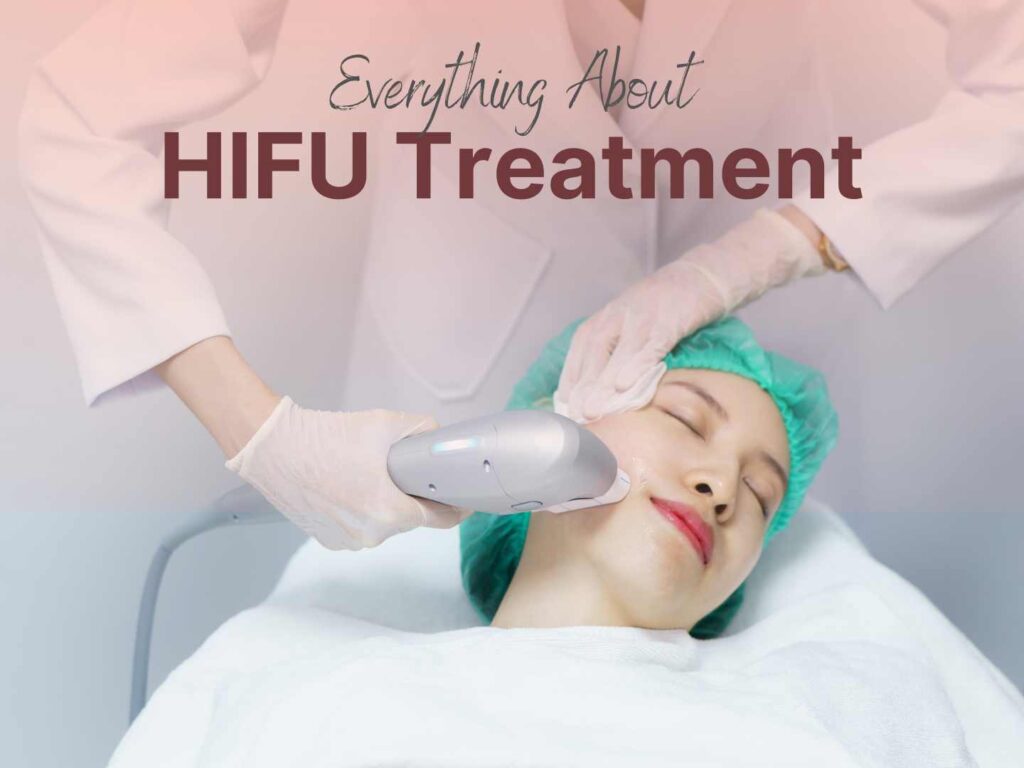Table of Contents
What is HIFU treatment?
High intensity focused ultrasound, otherwise known as HIFU, is a non invasive facelift. It does not involve any needles or downtime. HIFU utilises extremely concentrated ultrasound energy to tighten the skin and reduce unwanted facial fats.
In short, this treatment restores the collagen in your skin that was lost over time. The treatment targets collagen in the dermis and superficial muscular aponeurotic system (SMAS).
How HIFU treatment is done?
HIFU – The Art of Triple Layer Lifting
Without any needle/injection, HIFU has the ability to reach each layer of skin.. It strengthens each layer by delivering focused ultrasound energy to the skin, subcutaneous, fat and muscle layer.
At a depth of 3mm, the ultrasound penetrates the dermis to reach the skin’s collagen supply. Collagen is the supporting structure that anchors cells to one another. Collagen is what gives our skin strength and elasticity.
At a depth of 4.5mm, the ultrasound energy reaches the SMAS and heats it to 60° to 70°C. This is the same area that plastic surgeons target during surgical facelifts because it provides longer-lasting results than a facelift of the skin alone. As the ultrasound penetrates collagen in the SMAS, it causes a lifting effect of the face and neck.
As a result of the high amount of heat energy, it can also reduce fat under the skin, making it particularly useful to reduce double chins and hanging jowls.
Recovery time is typically faster with HIFU than with other treatments, patients can usually return to their normal activities within a few days after the procedure.
What Are The Benefits of HIFU treatment?
HIFU treatment has several potential benefits, including:
- Non-invasive: it is a non-invasive procedure, which means that it does not involve incisions or cuts. This reduces the risk of complications and makes recovery faster and less painful.
- Targeted treatment: It uses high-frequency sound waves to target specific areas of tissue, which allows for more precise treatment of the diseased or damaged tissue while minimizing damage to healthy tissue.
- Minimal side effects: It has minimal side effects compared to other treatments such as surgery, radiation therapy, and chemotherapy.
- No hospital stay: The procedure is typically done on an outpatient basis, and does not require a hospital stay.
- Fast recovery: Recovery time is typically faster than with other treatments, patients can usually return to their normal activities within a few days after the procedure.
- Potential to treat various conditions: It is used primarily to treat prostate cancer, but it’s also being investigated as a treatment for other types of cancer and non-cancerous conditions.
Which part of my face can undergo HIFU treatment
- Forehead: To lift and tighten the skin on the forehead, reducing the appearance of wrinkles and fine lines.
- Eyebrows: To lift and arch the eyebrows, creating a more youthful and alert appearance.
- Cheeks: To lift and tighten the skin on the cheeks, reducing the appearance of sagging skin and wrinkles.
- Jawline: To tighten and lift the skin on the jawline, reducing the appearance of jowls and creating a more defined jawline.
- Neck: To tighten and lift the skin on the neck, reducing the appearance of wrinkles and sagging skin.
How many sessions do I need for HIFU treatment?
Results can be appreciated in one single session. However, results may differ depending on the degree of skin laxity, your body’s response to ultrasounds and skins ability to reproduce collage. It is recommended to repeat the treatment 2-3 sessions in a year to maintain optimum results.
What result can I expect after the treatment?
Immediately after the treatment, you can expect firming and tightening effect. Over 6-8 weeks, collagen production will yield significant lifted results gradually. by reconditioning and renewing the skin from within, HIFU will lift the brows and cheeks, tighten the jawline and provide a more refreshed look overall.
Side effects of HIFU treatment
- Pain or discomfort: Some patients may experience pain or discomfort during or after the procedure. This is usually mild and can be treated with over-the-counter pain medication.
- Swelling or redness: The treated area may be swollen or red for a few days after the procedure. This is normal and should subside within a week.
- Bruising: Some patients may experience slight bruising around the treated area. This is also normal and should subside within a week.
- Numbness or tingling: Some patients may experience numbness or tingling in the treated area. This is usually temporary and should resolve within a few days.
Who is not suitable for getting HIFU treatment?
- Pregnant women: Not recommended for pregnant women as the safety of the treatment during pregnancy is not yet known.
- Bleeding disorders: May not be safe for individuals with bleeding disorders as it can cause bleeding at the treatment site.
Other than that, most people are safe to undergo the treatment, including you! But better safe than sorry, please consult certified aesthetic doctors to determine if your facial condition is suitable with the treatment.
Final Words
Do consult Kaiteki’s certified aesthetic doctor to determine whether you are a suitable candidate for HIFU Treatment
If you are looking to compare different facial treatment, check out this blog where we compare HIFU treatment and Fotona 4D!



